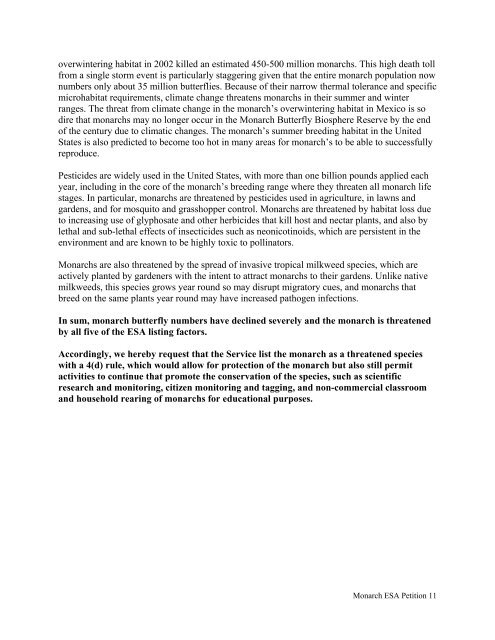monarch-esa-petition-final_61585
monarch-esa-petition-final_61585
monarch-esa-petition-final_61585
You also want an ePaper? Increase the reach of your titles
YUMPU automatically turns print PDFs into web optimized ePapers that Google loves.
overwintering habitat in 2002 killed an estimated 450-500 million <strong>monarch</strong>s. This high death toll<br />
from a single storm event is particularly staggering given that the entire <strong>monarch</strong> population now<br />
numbers only about 35 million butterflies. Because of their narrow thermal tolerance and specific<br />
microhabitat requirements, climate change threatens <strong>monarch</strong>s in their summer and winter<br />
ranges. The threat from climate change in the <strong>monarch</strong>’s overwintering habitat in Mexico is so<br />
dire that <strong>monarch</strong>s may no longer occur in the Monarch Butterfly Biosphere Reserve by the end<br />
of the century due to climatic changes. The <strong>monarch</strong>’s summer breeding habitat in the United<br />
States is also predicted to become too hot in many areas for <strong>monarch</strong>’s to be able to successfully<br />
reproduce.<br />
Pesticides are widely used in the United States, with more than one billion pounds applied each<br />
year, including in the core of the <strong>monarch</strong>’s breeding range where they threaten all <strong>monarch</strong> life<br />
stages. In particular, <strong>monarch</strong>s are threatened by pesticides used in agriculture, in lawns and<br />
gardens, and for mosquito and grasshopper control. Monarchs are threatened by habitat loss due<br />
to increasing use of glyphosate and other herbicides that kill host and nectar plants, and also by<br />
lethal and sub-lethal effects of insecticides such as neonicotinoids, which are persistent in the<br />
environment and are known to be highly toxic to pollinators.<br />
Monarchs are also threatened by the spread of invasive tropical milkweed species, which are<br />
actively planted by gardeners with the intent to attract <strong>monarch</strong>s to their gardens. Unlike native<br />
milkweeds, this species grows year round so may disrupt migratory cues, and <strong>monarch</strong>s that<br />
breed on the same plants year round may have increased pathogen infections.<br />
In sum, <strong>monarch</strong> butterfly numbers have declined severely and the <strong>monarch</strong> is threatened<br />
by all five of the ESA listing factors.<br />
Accordingly, we hereby request that the Service list the <strong>monarch</strong> as a threatened species<br />
with a 4(d) rule, which would allow for protection of the <strong>monarch</strong> but also still permit<br />
activities to continue that promote the conservation of the species, such as scientific<br />
research and monitoring, citizen monitoring and tagging, and non-commercial classroom<br />
and household rearing of <strong>monarch</strong>s for educational purposes.<br />
Monarch ESA Petition 11




